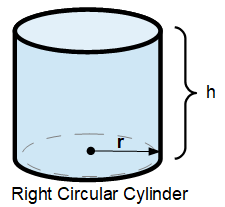The Weight of Metal Calculator contains functions and data to compute the weight (mass) of metal objects based on their size, shape and the density of the metal. NOTE: the default mean density typically provided is that of steel. However, this can be overridden with any mean density. See the table below.
The Weight of Metal functions are:
- Cylinder Weight: Computes the weight (mass) of a cylinder based on the radius, length (height) and density of metal.

- Sphere Mass: Computes the mass (weight) of a sphere based on the radius and density of metal.
- Cone Weight: Computes the mass/weight based on the mean density of the cone material (mD) and its volume as a function of the height (h) and the radius of the base (r).
- Cone Frustum Mass: Computes the mass (weight) of a right circular cone frustum defined by a top radius (a) and base radius (b), height (h) in between, using the mean density (mD) and volume to calculate the mass of the object. The frustum of a cone is also known as a truncated cone.
- Cone Shell Mass: Computes the mass (weight) of the shell of a right circular cone or cone frustum defined by a top radius (a) and base radius (b), height (h) in between, the thickness (t) and the mean density (mD)
- Hemisphere Mass: Computes the mass (weight) of a hemisphere based on the radius and density of metal.

- Weight of Metal Bars: Computes the mass (weight) of a number of metal flats or metal bars based on the dimensions and density of metal.
- Weight of Metal Rods: Computes the mass (weight) of a number of metal rods based on the dimensions and density of metal.
- Mean Density Lookup: Look-up utility that provides the mean density of hundreds of substances and minerals.
|
Metals Densities
|
Metals are materials characterized by its physical and chemical properties, primarily its ability to conduct electricity and heat, its luster or shine when polished, its malleability (ability to be hammered or pressed into shapes), and its ductility (ability to be drawn into wires). Metals typically have a crystalline structure and are found naturally in solid form (with the exception of mercury, which is a liquid at room temperature).
Metals make up a large portion of the periodic table of elements, with examples including iron, copper, gold, silver, aluminum, and titanium, among many others. Metals are essential in various industries such as construction, manufacturing, electronics, transportation, and energy production due to their unique properties and versatility.
Metals are generally dense materials. Density is a measure of how much mass is contained in a given volume. Metals tend to have high densities because their atoms are closely packed together in a crystalline structure. This close packing of atoms contributes to their characteristic properties such as strength, malleability, and conductivity.
However, it's important to note that the density of metals can vary widely depending on factors such as their elemental composition, crystal structure, and any impurities present. For example, some metals like lead and platinum are denser than others like aluminum or magnesium.
